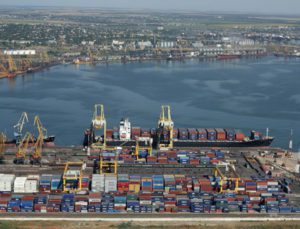
Ukraine imported 9.183 billion cubic meters (bcm) of natural gas for $1.801 billion in January-September 2019, including 1.481 bcm for $264.725 million in September, the State Statistics Service has said. The average price of gas imported by the country in September 2019 was $178.8 per 1,000 cubic meters, up 12.8% from $158.5 in August.
The main suppliers in January-September 2019 were companies from Switzerland with 4.05 bcm for $769.631 million, Germany – 2.827 bcm for $546.666 million, Czech Republic – 478.645 mcm for $91.23 million, Hungary – 462.888 mcm for $88.617 million, Poland – 342.778 mcm for $71.695 million, France – 356.617 mcm for $69.983 million, Austria – 267.171 mcm for $72.437 million, the U.K. – 154,599 mcm for $38.112 million, Luxembourg – 133.663 mcm for $32.256 million, Slovakia – 92.011 mcm for $16.215 million, Italy – 16.893 mcm for $3.487 million and Bulgaria – 1.4 mcm for $0.255 million.
Gas was not imported from Russia for the indicated period.
Ukraine imported 10.39 bcm for $3.12 billion in 2018.

Ukraine in January-October 2019 increased import of manganese ore and concentrate in natural terms by 29.4% compared to the same period in 2018, to 1.027 million tonnes.
According to customs statistics released by the State Fiscal Service of Ukraine, imports of manganese ore and concentrate in monetary terms grew by 18.7%, to $183.574 million.
Major imports were made from Ghana (75.99% of deliveries in monetary terms), Russia (20.46%), and Georgia (3.1%).
In January-October 2019, Ukraine exported 27,026 tonnes of manganese ore and concentrate for the amount of $2.587 to Hungary (40.59%), Slovakia (23.04%) and the Czech Republic (19.87%), while in January-October 2018 the country exported 53,617 tonnes for $3.527 million.
As reported, Ukraine in 2018 reduced import of manganese ore and concentrate in natural terms by 27.9% compared to 2017, to 938,946 tonnes. Imports of manganese ore and concentrate in monetary terms fell by 18.2%, to $182.788 million.
Major imports were made from Ghana (57.5% of deliveries in monetary terms), the Republic of South Africa (16.74%), and Russia (17.98%).
In 2018, Ukraine reduced export and re-export of manganese ore and concentrate in natural terms by 31.1%, to 59,597 tonnes, in monetary terms – by 19%, to $3.829 million. Exports and re-exports were carried out to Hungary (40.35% of deliveries), Slovakia (21.6%), and the Czech Republic (23.32%).
In Ukraine, manganese ore is mined and enriched at the Ordzhonikidze and Marhanets ore-mining and dressing mills (both based in Dnipropetrovsk region).
Dnipro-based PrivatBank controls the Stakhanov and Zaporizhia ferroalloy plants, Ordzhonikidze and Marhanets mills.
Nikopol ferroalloy plant (NFP) is controlled by EastOne Group, founded in autumn 2007 as a result of Interpipe Group restructuring, and Privat Group.

The seaports of Ukraine in January-October 2019 handled 129.8 million tonnes of cargo, which is 20.2% more compared to the same period in 2018. According to the press service of the Ukrainian Sea Ports Authority, the volume of grain and ore transshipment for the indicated period increased by more than a third.
At the same time, compared with the same period in 2018, the volume of grain transshipment grew by 37% (43.6 million tonnes), ore by 33% (30.5 million tonnes).
Transshipment of liquid cargo (oil, petroleum products, and others) rose by 9.6%, to 9.3 million tonnes.
In addition, according to data for January-October, the trend of container handling growth continues: in the ten months it increased by 19% (812,000 TEU).
The volume of exports increased by 24% compared with the same period of the previous year, imports by 12%, transit by 8%.
Among Ukrainian ports, five ports became the leaders in transshipment in the ten months, which provided the processing of more than 90% of the total cargo volume.
Over the ten months, the sea ports of Ukraine handled 9,800 ships, and increased the volume by 2.1% from last year’s figure.

The voluntary restructuring of feed-in tariff in wind energy is possible subject to other market reforms, according to a letter from foreign developers of large wind farms, namely NBT, Windkraft Ukraine, LongWing Energy, Greenworx Holding and Akuo Energy, which was sent to President of Ukraine Volodymyr Zelensky in late October.
According to the document, the restructuring may concern new wind farms or expansion of existing facilities, which will be commissioned on the basis of preliminary electricity sale and purchase contracts signed by the end of 2019, with the exception of projects or their stages being under construction or already having a financing agreement.
As an example, wind farm developers are considering a 5.0–7.5% reduction in the feed-in tariff rate for the wind farm project portfolio with a capacity of 1.9 GW compared to the feed-in tariff defined for wind farms for 2020–2022 in exchange for extension of the term of electricity sales contracts up to 15 years from the date putting wind farms into commercial operation.
At the same time, the authors of the letter oppose retrospective changes in the renewable energy market, drawing the head of state’s attention to the fact that the consequences of this option will be the loss of about $2.5 billion of direct investment, as well as the exit from the sector of foreign investors. According to the companies’ estimates, foreign investment in wind energy has already reached $1.2 billion, and an additional $2.5 billion is planned for the next three years.
In their opinion, the consequences of any retrospective changes to the previously approved by the law schemes for supporting wind energy incentives will be more significant than the problem of financing Guaranteed Buyer state enterprise.

The harvest of grain and leguminous crops in Ukraine in 2019, according to preliminary data, will be about 74 million tonnes, which is 4 million tonnes more than in 2018, Economy Minister Tymofiy Mylovanov has stated.
“In particular, wheat will amount to 28.1 million tonnes (3.5 million tonnes more), corn to 35 million tonnes (800,000 tonnes less), and barley to 8.9 million tonnes (1.6 million tonnes more),” he wrote on Facebook.